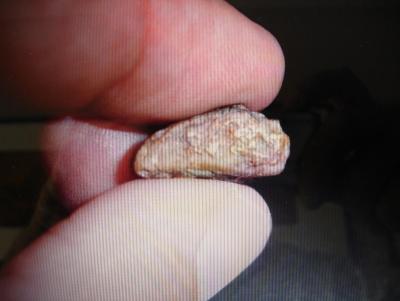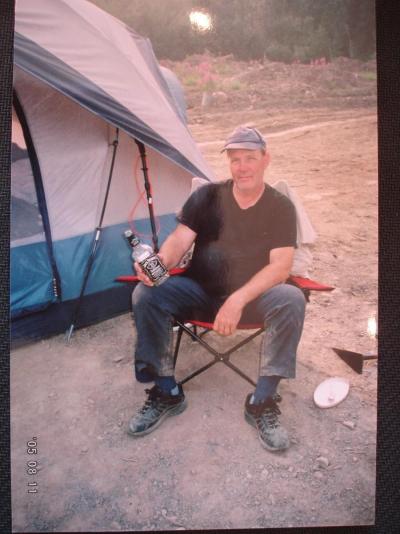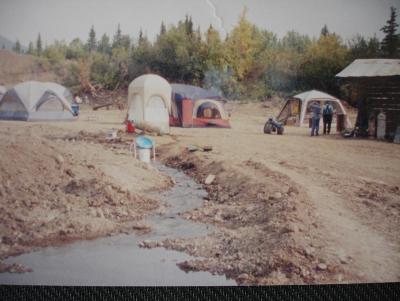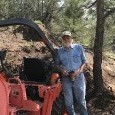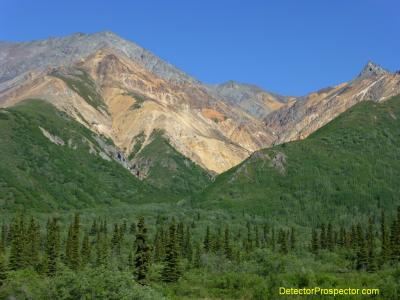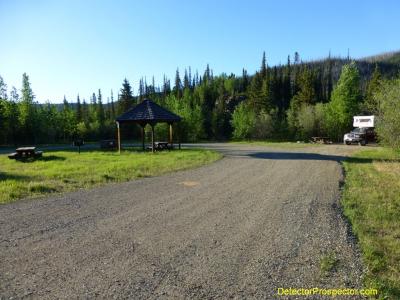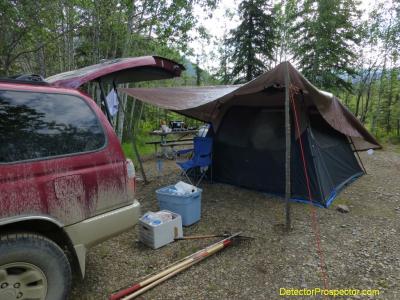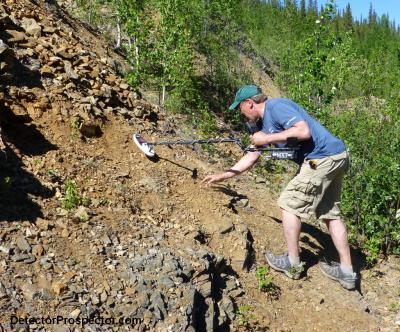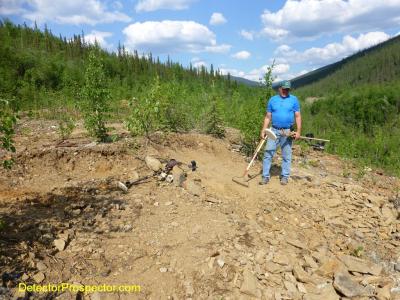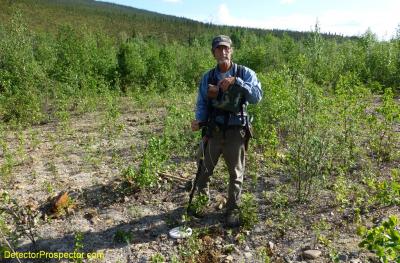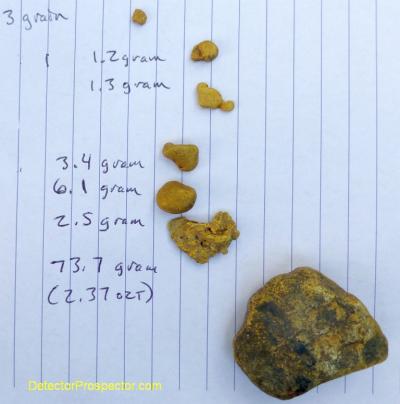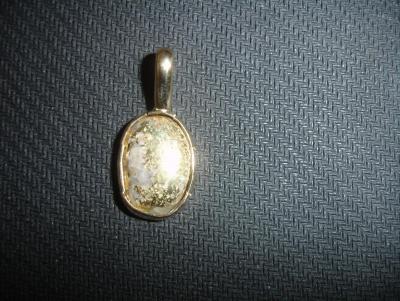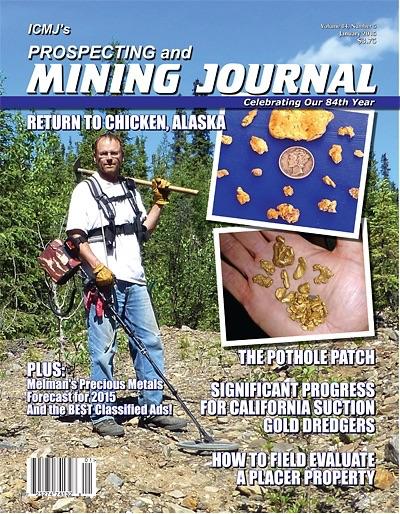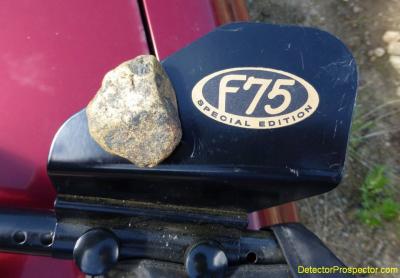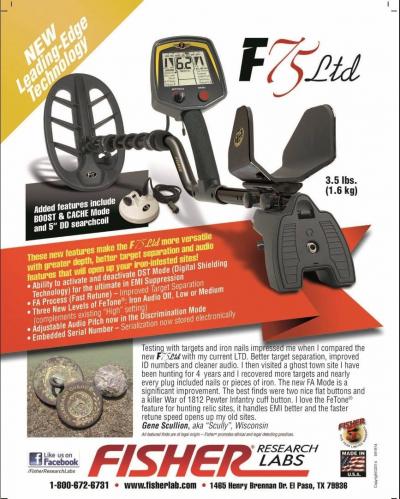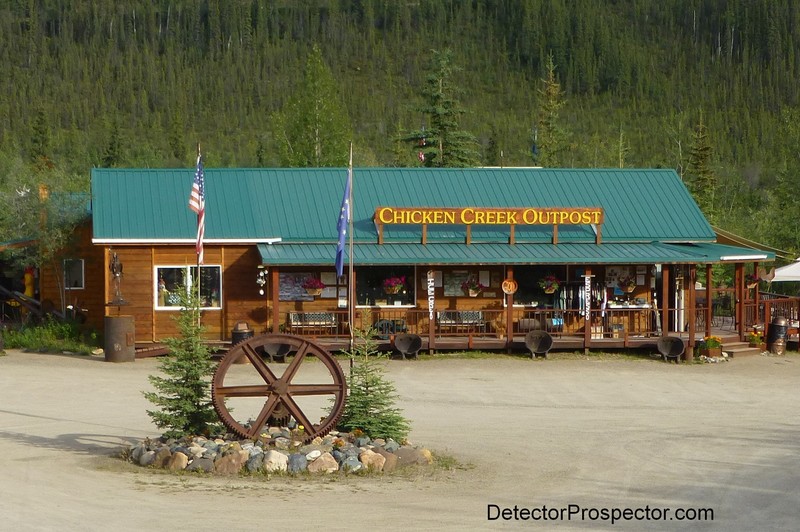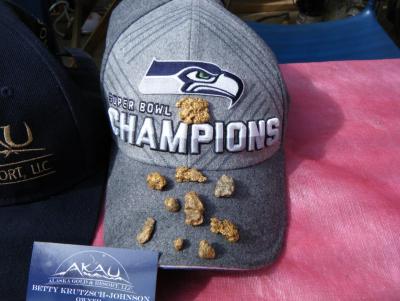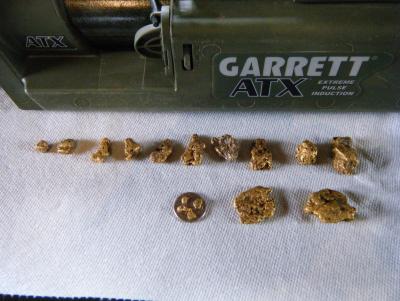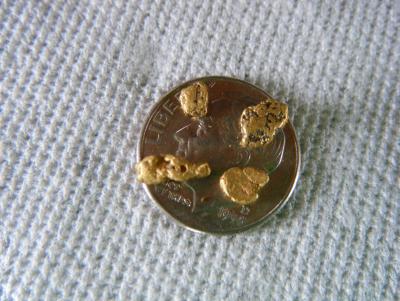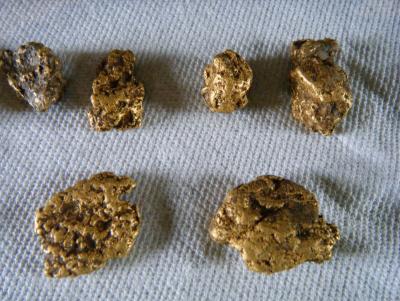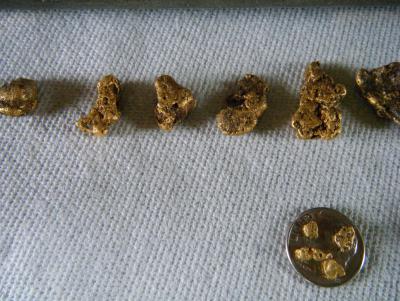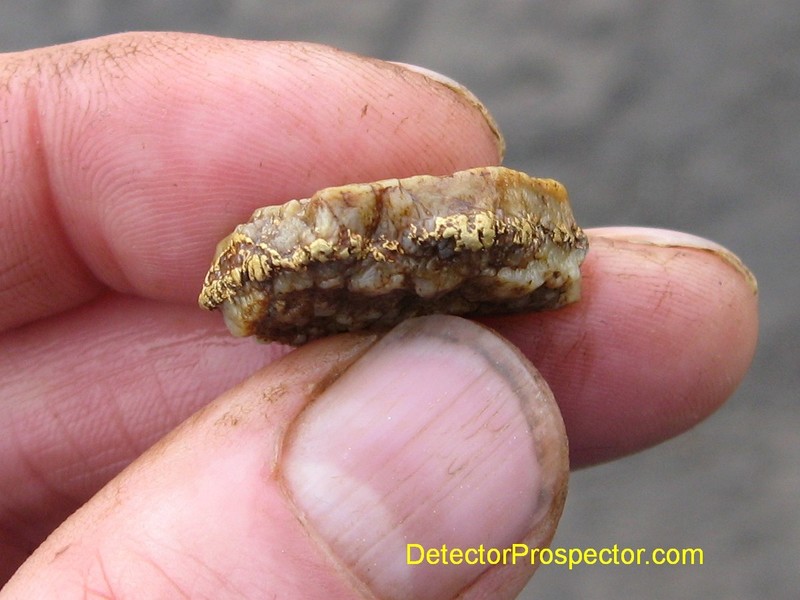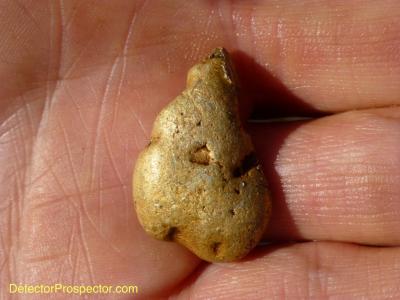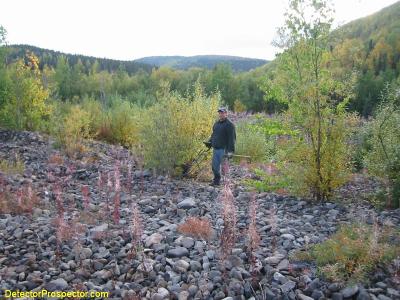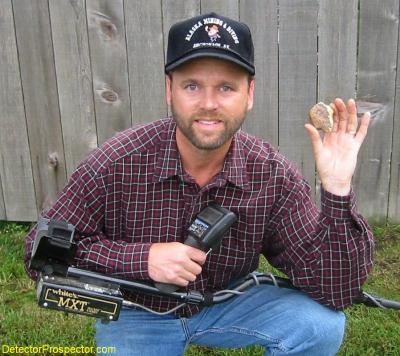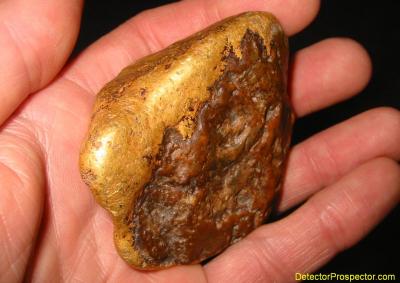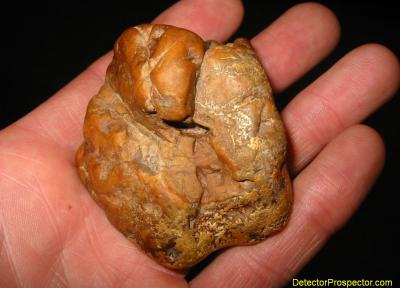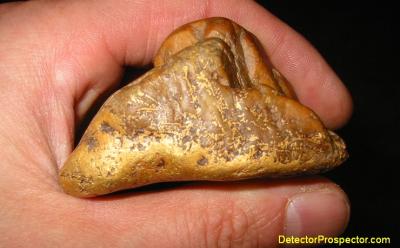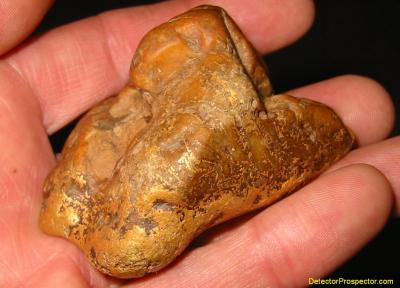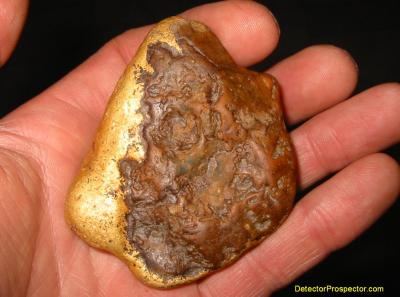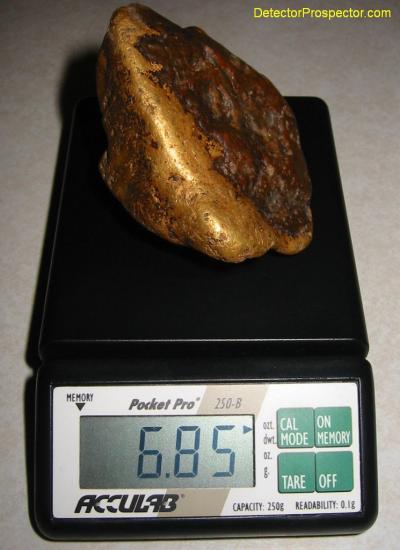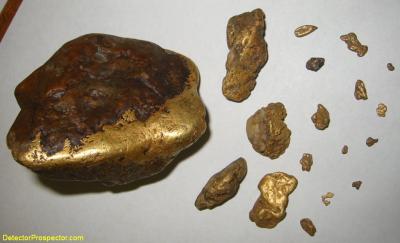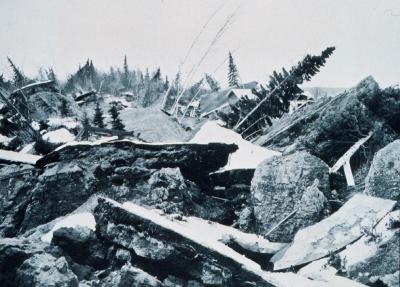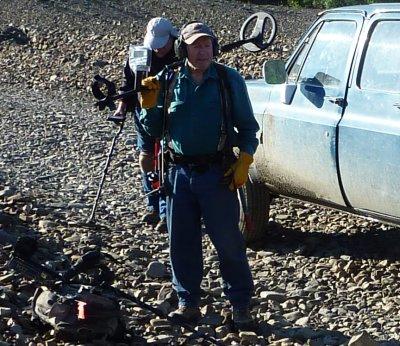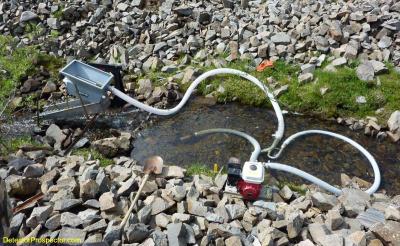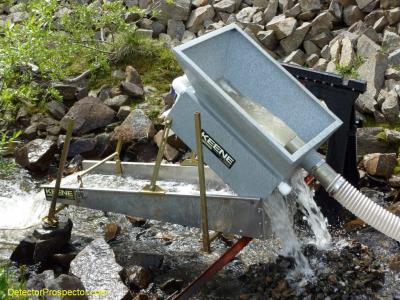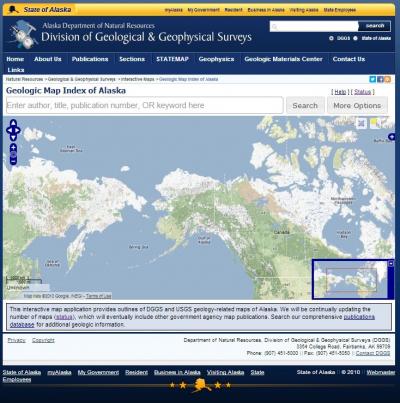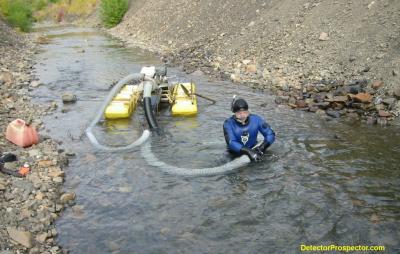Search the Community
Showing results for tags 'alaska'.
-
Hey, Steve; good article! http://www.icmj.com/article-notloggedin.php?id=3263 The article took me back to 2005 and Moore Creek. You ran an excellent camp! I don't know if you can link to the article I wrote about my trip there but someone may find it of interest... I found a few moore creek photos of my first speci, finishing the celebration and camp... thanks for the memories fred
-
Back in 1980 there was a Gold rush in Alaska and else where, as the price of gold hit over $800 an ounce. I and 3 friends went to Alaska to spend the summer mining for gold. Researching at the BLM in Anchorage it seemed pretty much everything accessible by vehicle was claimed up. One lady had staked 900 claims. After piddling around some public areas for a while, we made a deal with a claim owner to work one of his claims. His cut was 20% of what we found. It worked out well, as we found 27 ounces one week with our Keene super 4" dredge. My question to those in Alaska is, are there any claim owners willing to do that this coming summer? Thanks in advance for your replies! RSJ
-
I spent a couple months in Alaska prospecting for gold in the summer of 2014. That adventure was chronicled as it happened here on the forum at Steve's 2014 Alaska Gold Adventure. It was a great trip and a great adventure, but when I told it I relayed the fact that it was actually part two of the story. Part one happened in 2013 and for reasons you will now discover I kept quiet about it until now. Those interested in the logistics of making the trip to Alaska and details on where I stayed, etc. will find all that covered in the 2014 story so I will not repeat that stuff here. 2013 was a momentous year for me. My business partner and I had sold the business we started together in 1976 to our employees in 2010. My partner immediately retired but I stayed on a few years to oversee the transition. Things seemed to be going well enough that I announced my retirement to take place in the spring of 2013. My wife and I had purchased a new home in Reno, Nevada and so plans were made to sell our home in Alaska and move south. At the same time, some partners and I had acquired some mining claims on Jack Wade Creek in the Fortymile country near Chicken. Alaska. My plan was to move my wife south then spend the summer gold dredging with my brother. The disaster struck. I screwed up the paperwork and the claims were lost. That mess was described online at Making Lemonade Out of Lemons and I even wrote an article for the ICMJ about it. I was not to be deterred however and made plans instead to go metal detecting for the summer. Unfortunately, my brother also had a change of plans and so was unable to make the trip with me. Just as well as I ended up having my hands full. The house sale was in progress and time running out so I boxed and palleted everything we wanted to keep and shipped it south. Then I loaded my wife and dogs up in the car and drove them to Reno. Next I flew back to Alaska and had a last big garage sale. I sold everything I could by the afternoon and out a FREE sign on what was left. Worked great - the house was empty, I cleaned it up, and pretty much left it to the realtors at that point. Finally, on June 16th I jumped in my fully loaded truck and headed for the Fortymile! On the way up just past the town of Palmer on the way to the town of Glenallen you pass Sheep Mountain in the Talkeetna Mountains. It is a very colorful, mineralized peak and it was a beautiful sunny day so I stopped and took this photo. Sheep Mountain, Alaska From the USGS ARDF file at http://mrdata.usgs.gov/ardf/show-ardf.php?ardf_num=AN080 Early Jurassic greenstone and minor interbedded sandstone and shale is intruded by numerous mafic dikes and at least one body of unmineralized Jurassic granite. Greenstone has been hydrothermally altered and contains at least 6 separate gypsiferous deposits in altered zones along joints and shear zones. Deposits composed of pods and stringers of gypsum, quartz, alunite, kaolin minerals, pyrite and serpentine minerals (Eckhart, 1953). The gypsum-bearing material averages 25 to 30 percent gypsum, with a maximum of 50 percent. In addition also reported from same general area are: (1) small irregular quartz-calcite-epidote veins in greenstone containing chalcopyrite, malachite, azurite and possibly bornite and chalcocite (Berg and Cobb, 1967); (2) disseminated chalcopyrite in greenstone over 5 ft thick zone subparallel to bedding (Martin and Mertie, 1914); (3) trace gold in samples of pyritic greenstone (Berg and Cobb, 1967); and (4) minor anomalous concentrations of copper and gold associated with some of the alteration zones and nearby veins (MacKevett and Holloway, 1977). Large area of south flank of Sheep Mountain is stained dark red from oxidation of pyrite in greenstone (Berg and Cobb, 1967). Oxidation of Cu minerals. The gypsiferous material averages 25 to 30 percent gypsum, with a maximum of 50 percent. The six deposits indicated and inferred reserves contain about 659,000 short tons of gypsum material, of which about 50 tons of this material had been mined (Eckhart, 1953). In addition, about 55 tons of clay was mined for the manufacture of fire brick and boiler lining. Samples of pyritic greenstone assayed trace gold (Berg and Cobb, 1967), and nearby veins in alteration zones show concentrations of copper and gold (MacKevett and Holloway, 1977). We did a talk radio show for many, many years at our company. The latest of several "radio personalities" to work with us on the show was Kurt Haider. He had expressed an interest in metal detecting so I invited him up to look for gold. I met him along the way just before we got to Glenallen and headed on to Tok for a bite to eat at Fast Eddie's. Then on to Chicken and finally Walker Fork Campground by evening. This is a very nice, well maintained BLM campground at the mouth of Jack Wade Creek where it dumps into the Walker Fork of the Fortymile River. The campground hosts this summer were a very nice couple named Pat and Sandy. Walker Fork Campground Steve's Camp at Walker Fork Campground The next morning Kurt and I ran up the creek to find Bernie and Chris Pendergast. They were spending the summer camped along Jack Wade Creek prospecting and I was anxious to see how they had been doing. Not bad, they already had over an ounce of gold found before we arrived, and that got Kurt and I all fired up to go look for gold. I had told Kurt, a total newbie, that I had a sure thing. We were going to hit a bedrock area I had detected the previous summer and where I had found a lot of nice fat little nuggets. There was rubble and little piles of dirt, and I thought all it would take is moving the rubble and dirt aside and we were sure to find gold I had missed. We got started after lunch on a steep slope where it was easy to just rake material off and then check with a detector. Kurt Looking For Gold With White's MXT Pro The location turned out to not be very good, but Kurt did manage to find one little nugget, his first ever. He was real happy about that! We did not work at it all that long though with the late start, and Chris and Bernie had invited us over for moose stew. Chris is a fantastic cook so we enjoyed both the stew and a DVD packed full of Ganes Creek photos from the couples adventures there. Finally we called it a night and headed back to our camp. Now time to get serious! Kurt and I grabbed the picks and rakes and spent the whole day tearing into some berms left behind by the miners bulldozers on the bedrock bench area. I just knew we were going to find gold for sure. We would both do hard labor for awhile, then I would put Kurt on the ground with my Gold Bug 2. Working Bedrock With the Gold Bug 2 We worked a couple hours. Nothing. No big deal, just need to move a little more. Nothing. More digging and scraping. Nothing! I would have bet $100 we were not only going to find gold there but do pretty well. The spot had produced quite a few nuggets before and I had refused to believe we couple possibly had cleaned it out. But by the end of the day it was a total bust. We finally just wandered around a bit detecting and I lucked into a little 3 grain nugget. What a letdown. No big deal for me but I was really wanting Kurt to do well and this was not working out anything like I had thought it would. The next and last day for Kurt we decided to hook up with Bernie and just give it a go like we normally do. And that means hitting the bushes and tailing piles wandering around looking for gold. Kurt had his MXT Pro and Bernie and I our GPX 5000 detectors, so we had a horsepower advantage for sure. Still, I was hopeful as we put Kurt on the best spot that Bernie knew of from his extra time before us. Bernie Pendergast and His Trusty Minelab GPX 5000 Very first beep, Bernie digs up a 3 pennyweight nugget! Yeehaw, we are going to find gold!! We all hunt away, with Bernie and I checking in with Kurt periodically. Kurt, it seems, just was not destined to have any beginners luck at all; Bernie and I each found a couple 1-2 gram nuggets by the end of the day but Kurt came up dry. I was feeling kind of bummed out but Kurt insisted he was having a huge adventure, and come to find out he rarely ever got out of town at all, so this really was a big adventure for him. I just wish he could have found more gold, but he was up early and headed back to town the next morning. I was on my own now, so I rigged my GPX 5000 up with my Nugget Finder 16" mono coil and hit the tailing piles. All day. For no gold. However, just by myself that is really no big deal at all. It happens all the time and I do not think anything of it. If anything, the pressure was off trying to help a friend find gold, so it was a relaxing day wandering around. Saturday, June 22 started out sunny with a few clouds. There were some tailing piles across the creek I had been wanting to detect. I had hit them a bit the year before and just dug trash, but had not put in more than a couple hours at it. Still, they looked real good and I had been thinking about them all winter and decided it was time to give them a go. I started out with my GPX 5000 but immediately got into some old rusted metal, like decomposed and shredded can fragments. I just was not in the mood for it that morning, so went back to the truck and got out my Fisher F75. The F75 had done well for me in the past hunting trashy tailing piles and was along on the trip for that reason. I got near the top of the pile with the F75 and on getting a signal looked down and saw a dig hole full of leaves. I try to recover all my trash and get frustrated when I find holes with junk in them. The signal though was flaky, not a distinct trash signal, so I figured I may as well see what the other person left in the hole. I gave a quick scoop with my pick, and gold pops out of the hole! I am not sure if the person was using a VLF and the specimen gave a trash signal, so they left it after half digging it, or maybe they were using a Minelab, and the signal just sounded "too big" so they left it for trash. Too big indeed, they walked away from a 2.37 ounce gold specimen! To say I was stunned would be a vast understatement. The trip had only just begun. The best part of all was that my expectations for the trip were very low. I had been hoping that a month of camping and detecting would get me a couple ounces of gold. That would be more than enough to cover my expenses and make a few bucks. Yet here I was on the sixth day of my trip, and I had already exceeded that amount. This was just great on several different levels, not least in pretty much taking every bit of pressure off going forward. Here is that specimen from a more detailed account of the find I told previously at Fisher F75 Strikes Gold Twice in a Row! 2.37 Ounce Gold Specimen Found With Fisher F75 Metal Detector on Jack Wade Creek, Alaska I had to take a break and go show Chris and Bernie my good fortune. Then I switched back to the GPX 5000 and got with digging everything, including all those bits of rusted cans. Funny how a nice chunk of gold changes your perspective. That, and seeing what somebody else had left behind as trash. I finished out the day finding three more nuggets, a 2.5 gram "cornflake" nugget, a 3.4 gram piece and and fat round 6.1 gram marble. First week, 2-3/4 ounce of gold, This was shaping up to be a really great adventure! To be continued...... Steve's Gold From Jack Wade Creek, First Week 2013 This post has been promoted to an article
-
Today my youngest daughter and my second child is 40...dang, I am getting old! Happy Birthday Crystal! For her birthday i am sending her a pendant that was fashioned from my first piece of Alaska-thank you Steve H; almost ten years ago at Moore Creek. Steve aka El Dorado made the cab and turned an ugly duckling into a swan-thank you El D. He is a mighty fine artisian! The setting was done by a local jeweller and I wish I had had El D do the work but done is done. Unfortunately, I lost the photos of Alaska when my puter-died...(Steve you have/had a copy of that article in your stuff) The specie was about the size of a nickel and was rock with a slice of gold in the middle... fred
-
I am a big fan of the Fisher F75 from a different perspective than most. I am a prospector and have done very well finding gold nuggets with the F75. The very powerful all metal mode combined with the simultaneous on screen target id numbers have allowed me to quickly and efficiently hunt trashy tailing piles in search of large gold nuggets. The light weight and superb balance make the F75 a pleasure to use for long hours in rough terrain. It also was my detector of choice for my one and only trip to the UK that I have done so far, and it served me well there. I spent a month in 2013 metal detecting on Jack Wade Creek near Chicken, Alaska. I kept my great results there quiet pending a return trip there in 2014. That trip has now been made but that is another story already told in detail on my website. Now I can finally reveal the details of the 2013 expedition. I started out early one morning with my big gun pulse induction metal detector, but got onto a tailing pile that had ferrous trash scattered down one side, and I was just not in the mood for it that morning. I went back to my truck and got out my trusty F75. I run the F75 in all metal because it has instant target response; there are no worries about recovery times in all metal. The coil picks up every variation not only in targets but in the ground allowing me to monitor what is going on at all times. Knowing what the ground is doing is important in keeping the ground balance properly adjusted for maximum results. The key thing I like about the F75 in all metal however is that the meter always runs in discrimination mode and places a nice, large target number on screen while in all metal. The audio alerts me to a potential target, which I then analyze more carefully while watching the target numbers. All metal goes deeper than discrimination modes, so no on screen number means a very deep target beyond discrimination range. This alone makes running in all metal desired when prospecting because running in discrimination mode would miss all those extra deep signals. In all metal I dig them until a target number shows up. Deep targets or small targets in mineralized ground will often read ferrous, so I watch the numbers and if they even once jump to non-ferrous, I dig. Only targets that give a 100% strong ferrous reading over multiple sweeps can be safely passed. Though I will throw in my caveat that no discrimination system is 100% accurate and there is always a risk of passing a good target. When in doubt, dig it out! I do often employ pulse induction detectors and do very often just dig everything. I advocate that when time and conditions allow. The reality is this is not always practical for many reasons. Maybe it is just limited time and overwhelming amounts of junk. Better to increase the odds by using discrimination than bogging down digging 100 nails in a small area. In my case it often boils down to fatigue or flat out not being in the mood to dig junk. So it was on this particular morning, and therefore my F75 came out and I got to work sorting through the trash working my way up the side of the tailing pile. I crested the top and got a strong reading and looked down. There was a shallow dig hole with leaves in it, obviously from some hunter there in prior years. I figured the guy had recovered a trash item and kicked it back in the hole so I cussed him quietly under my breath. I hate it when people do that! Then the target numbers caught my eye. They were all over the place. A crumpled piece of flat steel might give numbers like that though. Still, I was curious and figured I would retrieve the trash this person left in the field. I gave the old dig hole a big scoop, and out pops a big gold nugget!! I seem to have a talent for finding ugly gold nuggets, and this one was perhaps the ugliest I have ever found. It looked more like a rock burnt in a fire than a gold nugget when I dug it up, though the glint of gold is unmistakable. This gold however was very pale and in fact later analysis revealed it to be roughly half gold and half silver and other metals. It is a little known fact that gold alloys tend to have very poor conductivity ratings. Gold is very conductive, and silver is a superb conductor. You would think adding silver to gold would improve the conductivity, but in fact just the opposite happens, and the conductivity lowers dramatically. Gold/silver alloys are closer to lead in conductivity than that of the pure component metals, explaining why bullets read identically to most gold nuggets. This ugly nugget is a detectorists worst nightmare, because the 50-50 alloy mix and rock content give it a much lower conductivity reading than would be the norm. I surmise what happened is this earlier operator got a poor signal and gave a dig to get the coil closer to the target. The signal did not improve, as would be expected with most gold nuggets, so the operator decided it was trash and moved on. The rest of the hill being covered with junk no doubt contributed to this decision. It was my insistence on investigating everything except 100% ferrous readings that made the difference. The readings on this target were not solid as one would expect from a pretty strong signal but all over the place. Most people would say that indicates a trash target but I have seen many gold nuggets do the same thing in mineralized ground. The result is I dug a shallow 2.33 ounce gold nugget that somebody else walked away from. Sadly for them one more scoop would have revealed the nugget for what it was. Hopefully this is a reminder to the reader that far too often detectorists look for excuses not to dig. How many good finds get left behind because we do not want to take that extra minute or two to dig a target? This nugget is far from a premium find, but I have already sold it for over twice the cost of a new Fisher F75. That detector was a real money maker for me as that was far from the only gold I ever found with it. Unfortunately I say was. I made a huge change in my life in 2013 and moved from Alaska to Reno, Nevada. The move resulted in a desire for me to weed down my detector collection. I was pretty excited to do some coin detecting in Nevada where the potential finds were much better than those possible around Anchorage, Alaska. Almost all my detecting with the F75 had previously taken place in rural locations far from possible electrical magnetic interference. In Reno, EMI raised its ugly head. I found much to my dismay that the F75 did not like my new location, and in fact when turned on to hunt the yard at my new home I could not get it to settle down at all. No matter what I did the machine chirped and beeped and numbers flew all over the screen. Unfortunately I experienced what many urban hunters have found out – the F75 is a very sensitive high gain detector that does not get along well with electrical interference. I ended up selling my F75 in 2013 for this sole reason. Fast forward to the fall of 2014. I am contacted by the good folks at Fisher wanting to know if I am interested in trying out a new version of the F75 they are preparing for market. I of course say sure as I am always game to go metal detecting with different units. A new F75 is sent my way along with a list of the possible improvements. One immediately gets my attention – improved resistance to electrical interference. All the focus was on a new mode or “process”, as Fisher likes to call them. The new FA process is intended to better pull non-ferrous items out of trashy or mineralized ground. It does indeed work as advertised as I found out in an accidental situation I came across. I went to a local park and did a simple hunt for non-ferrous targets, comparing the DE default mode to the new FA fast mode. I did not really care what I found as long as it was non-ferrous. I should note the ground here is very difficult, reading 1 on the Fe meter, the second highest reading you can obtain. Hunting in this park is very much like nugget detecting, and the best detectors get very limited depth and highly inaccurate target numbers as a result of the high mineralization. One spot really summed it all up for me. I found three targets I could cover in a single wide swing that all read as ferrous in DE mode, but when I switched to FA mode all three switched to non-ferrous. FA mode is very fast with short, machine gun type reports in the audio. I was running in two tone mode, with ferrous giving low tones and non-ferrous high tones. In DE mode I could sweep and get three low tones in a row. Simply switch to FA mode and now there were three high tone reports in a row. This was an extremely dramatic result seen in person. In this case all three targets proved to be nothing more than aluminum targets, but they could just as well have been small hammered coins in the UK or small gold nuggets in Alaska. I hate to oversell things and I have to note that the difference in going to FA mode is not going to be earth shaking. Most targets read the same in DE and FA modes. But FA provides a tipping point, a little push that takes targets previously ignored and lights them up. By shortening the audio response on targets it also attenuates responses to a degree and so depth and signals on the tiniest targets may be impacted. Depth however is not useful if a target is misidentified or ignored completely due to target masking from nearby objects. FA mode is another tool in the toolbox that can help produce targets in specific situations previously overlooked by others. The new F75 also expands on the available audio options in ways many people will appreciate. These additions and the new FA mode will tend to get all the attention, but for me they pale in comparison to the new ability of the F75 to engage and disengage the new Digital Shielding Technology (DST). The version of the F75 I received had DST engaged at all times, and the difference in my ability to use the F75 at my home was as dramatic as it gets. My previous F75 was basically non-functional. My new F75 ran just fine, with only minimal EMI discernible at higher gain levels. I noted no downside to this. Given the situation, how could there be? Other field testers however were concerned that in low EMI situations perhaps there was an edge lost by having DST engaged, and so Fisher decided to add the ability to engage or disengage the feature as desired. It does not get any better than that. Use it if you need it; leave it off if you do not. All I know is this. What difference is there between a detector you can use and one you cannot use? All the difference in the world, and in my opinion I struck gold a second time with the F75 seeing it run with the new Digital Shielding Technology. That one feature alone means I can use the F75 in urban areas where I could not use it before, and vastly improves the reasons for my owning the detector once again. I am very confident a great many people will agree with me when they get a chance to try out the new, improved F75. Everything else in my opinion is just icing on the cake.
-
Paradise Valley is the oldest operating metal detector "pay-to-mine" operation in Alaska. The area to detect is small compared to what was available at Ganes Creek and Moore Creek and the nuggets smaller, but some great finds have been made there over the years. I was browsing around and just found a thread with some recent photos from Paradise Valley at Link deleted since Findmall update broke all old links The actual Paradise Valley website is at http://www.akpub.com/akttt/parad.html
-
Steve, enjoyed your article about this dredge in the October issue of the IMCJ Prospecting and Mining Journal. I hope to get to the Chicken area someday. When I was a young boy in the late 1940's I had the opportunity to see a similar dredge operating in Prickly Pear creek south of Helena, Mt near Clancy. The dredged area is now pretty much covered by I-15 and the dredge is gone after sitting by the highway for many years. The picture is from a website showing a number of historical pictures from the area south of Helena. http://www.helenahistory.org/south_of_helena.htm Also, at this site just past the dredge image is a newspaper article about the dredge.
-
Thanks Steve for letting me know about the Garrett find of the month and sending them my story. I actually won for September and am now the proud owner of a AT GOLD detector. A good machine to go along with my ATX! Thanks again and good luck looking for GOLD! Hope to meet you again someday in the gold fields. David Frickelton (ezdave)
-
Edit: I chronicled this trip to Alaska first, and then told the story of my earlier 2013 Alaska Trip after the fact. I did well enough in 2013 I did not want to tip anyone off to what I was up to until I had a chance to return in 2014. Therefore this story got told first, as if the other had not happened. And then the 2013 story was told at the link above. My history with the Fortymile Mining District of Alaska began in the 1970's and has continued off and on ever since. Last summer I spent considerable time in the area and have decided to return again this summer. Here is the basic plan. I leave Monday to drive from Reno to Alaska. I am stopping a day to visit family in Olympia then will continue to Anchorage, where I will pick up my brother Tom who is flying up from the Lower 48. Then we will backtrack to Chicken, Alaska and pitch a tent site at the Buzby's Chicken Gold Camp http://www.chickengold.com Main building at Chicken Creek Gold Camp Last year I mostly camped around but did spend a period of time at the Buzby's operation. When I was out and about I had to activate my satellite phone to stay in touch because there is no cell phone service in the Chicken area. The nearest cell phone access is a couple hours back along the road at Tok. There is WiFi access at several locations in Chicken however, one of them being at Chicken Gold Camp. The WiFi access is included in the price of staying there. I am getting a dry camp site for $14 a day (6 days get seventh day free) but it saves me $300 activating my satellite phone, and WiFi allows me to keep on the forum and stay in better touch with my wife than the sat phone. Bottom line not activating the sat phone ends up paying for nearly a month of staying at Chicken Gold Camp. Right now I am booked from June 15 until July 20 but may extend. Since I will have pretty much daily Internet access for the entire trip I am inviting you along via this thread to see how we are doing plus to perhaps answer questions for anyone planning to visit Alaska. The Internet access in Chicken is not the greatest even at its best, as the satellite dishes point straight at the horizon just trying to get a signal. That being the case plus I will be busy I will not be posting on other forums for the duration. If you know anyone who might be interested in following this point them this way. I will report in at least a couple times a week and probably more often as time allows or something interesting happens. My brother and I will be commuting to various locations from our base camp in Chicken, with a lot of attention paid to Jack Wade Creek about 20 minutes drive up the road. I have access to mining claims on this and other creeks in the area, but we will also spend considerable time on the public access area on the lower 2.5 miles of Jack Wade Creek. Visit this link for more information. This area is open to non-motorized mining and we will of course be metal detecting. I have detected on Jack Wade a lot, and I can tell you it is an exercise in hard work and patience. It is all tailing piles full of nails and bullets. The nuggets are very few and far between, with even a single nugget in a day a good days work. However, the nuggets are solid and can be large so can add up if you put in a lot of time. Or not as luck does have a bit to do with it. You could easily spend a week detecting Wade Creek and find nothing. So do not be surprised when I make lots of reports indicating nothing found on a given day. We fully expect that to be the case but hope we hope a month of detecting here and at other locations will pay off. I plan on relying mostly on my GPX 5000 but will also be using a Gold Bug Pro for trashy locations or for when I am tired from running the big gun and want to take it easy. I usually run my 18" mono coil on the GPX unless in steep terrain or brushy locations and dig everything. And that means a lot of digging! The Gold Bug Pro eliminates digging a lot of trash and is easy to handle in thick brush. My brother will mostly use my old GP 3000 he bought from me years ago. I am also bringing along the Garrett ATX kind of for backup and also to experiment around with. It also will be easier to use in brushy locations than the GPX. Finally, I hope to possibly have a new Minelab SDC 2300 get shipped to me somewhere along the way to use on some bedrock locations I know of that have been pretty well pounded to death. Chris Ralph will be arriving in Fairbanks on July 8th so I will drive in and pick him up. He will be staying with Tom and I until I return him to Fairbanks on July 21. High on the list is to visit with Dick Hammond (chickenminer) and other friends in the area. The road to Alaska is just another highway these days, with the only real issue being the lack of gas in northern Canada in the middle of the night. The pumps there still do not take credit cards so when the gas station closes you are stuck there until it opens in the morning. Do not try to get gas at Dot Lake at 2AM! I will drive to Olympia to spend a night and day with my mom (12 hours) then on to Dawson Creek/Fort St. John (16 hours), then to Whitehorse (15 hours), and then to Anchorage (12 hours). Four days driving, about $500 in gas for my Toyota 4-Runner. Pick up Tom and some supplies and then back to Chicken (about 8 hours). Anyway, you are all invited along at least via the internet to share in the adventure. You have any questions about Alaska in the process then fire away.
-
Just returned from Nome Alaska where I managed to find 16 nuggets in 6 days! All with the ATX with the 8 inch mono ( lighter weight for all day swinging) Met Steve in Happy Camp and took his advice as to use the 8 inch mono and dig all targets. Dug plenty of junk but also some nice GOLD. EZDAVE
-
Back around 2008 I was involved with the use of the White's TDI in a very big way at my mine at Moore Creek, Alaska. I made various posts at locations around the internet on our success with the TDI but never did get around to collecting it all together in one place. Until now. I just made a belated entry on Steve Mining Journal titled White's TDI at Moore Creek, Alaska - Summer 2008. Lots of gold nugget stories and photos there - check it out. Also added a page about the TDI itself I am still working on but a ton of information there at White's PulseScan TDI Metal Detector already so went ahead and posted it. 0.31 ounce Gold Specimen found with White's TDI
-
Hi all, its looking fantastic outside, things are starting to warm up here in Ak. Planned a trip already here in a week or two to see if I can find some of that yellow stuff. I know Memorial day is comin up, and it would probably be best to go around then, but I gotta get out of the house. Anyone else have any plans? Good Luck out there, Jack
-
Here are some closeups of the 6.85 ounce gold specimen I found at Ganes Creek, Alaska in September of 2002 with a White's MXT. It has a solid gold core surrounded by dark reddish brown lustrous quartz. Theoretically no gold is ugly but I thought this one was so I dubbed it "The Ugly Nugget". The full story and more photos are at Garrett Infinium & White's MXT at Ganes Creek The quartz is representative of one of the several sources of gold at Ganes Creek. The quartz verges on being agate but not quite, is always a shade of brown or reddish brown, and commonly has wisps or sponge-like masses of dendritic (mossy) gold enclosed in the quartz. I will find pictures of other examples. Gerry McMullen found a huge one at Ganes in later years. My buddy Jeff and I were hunting way down below camp. We were on old cobble piles way back off the road near the creek, and I swung over the bank on one edge down into the bushes with my White's MXT. I got a loud signal and with a couple swipes of my pick basically just laid the moss back, and there it was. I did not think it was as big at the time as it turned out to be when it weighed in at 6.85 ounces. This still is the largest gold nugget/specimen I have found to date, though a solid 6.5 oz nugget I found last summer may have more actual gold in it. I eventually sold the nugget to Mike Robuck at The Alaska Mint http://www.alaskamint.com/ and it was still on display there when I visited last summer. It is not for sale but used as a set piece to show off gold chains draped over it. If you ever are in Anchorage make the Alaska Mint part of your visit because it is more like a museum inside than a jewelry store. The first picture below shows the general terrain the nugget was found in, Jeff with MXT in the photo. The last photo shows the other 1.3 ounces of gold I found on that visit to Ganes Creek, 8.15 ounces total.
-
Fifty years ago I was six years old sitting on the couch at home watching TV in my home town of Anchorage, Alaska. We lived in a new subdivision called Turnagain-By-The-Sea. It was Good Friday and I was watching an afternoon children's show, Fireball XL-5. The old black and white TV shut off, the picture shrinking down to that little white dot. Our dog was running like crazy through the house and and the house began to slowly move like a ship at sea. Earthquake! My parents gathered my siblings and I in the living room which by then was moving up and down so much we could not walk, and so we just huddled together in the middle of the room and held on to each other. The house was riding ground swells up and down and it seemed to go on forever. Everything loose in the house was falling over and everything in cabinets was crashing to the floor. I have been in very many earthquakes now in my life but this was totally different. Most quakes are a quick jolt or a shake. This was a very slow movement up and then down, exactly like being in sea swells. The ground raised us up, and then dropped away below us. It was very frightening to have solid earth turn into nothing of the sort. Instead of seconds the quake lasted for several very long minutes. Finally the movement subsided and we were all fine. A forest that used to be between the Turnagain subdivision and the inlet was gone, replaced by a sunken crazy quilt of broken land and trees. Houses once visible out our back window had gone over the edge. My father was in the National Guard and was called out to help while the rest of us were evacuated to high ground for fear of tsunamis. That thankfully never appeared in Anchorage but which devastated other communities in Alaska. http://time.com/3746785/the-great-alaska-earthquake-of-1964-rare-photos-from-an-epic-disaster/ The photo below is what the land behind our subdivision looked like. A huge chunk of land broke up and slid out into the inlet. It later became Earthquake Park. Fifty years of erosion have reduced it to rolling terrain with trees once again growing vertically. I was young but the memories of the most powerful quake ever recorded in North America will always be with me. http://en.wikipedia.org/wiki/1964_Alaska_earthquake
-
Hi steve i attended your class a few years ago and really enjoyed it. I have a specific question. I want to target flakes and pickers and small nuggets behind my house in basically the Talkeetna mountains, which include hatcher pass, sutton area, willow, and numerous high small streams that i hike and four wheel into. from all the research i have done the fisher gold bug 2 seems to be the ticket and i see you have used it with great success. my question is this area a high mineralized area? i see the gold bug 2 is very sensitive to hot areas, i plan on using it a lot and practicing on the little sue with practice targets, is this something i need to be concerned with ? (also will be hitting crow creek,petersville and eureka) but mostly hatcher pass and sutton area. what are your thoughts on this?
-
There were amazing finds made at Ganes Creek, Alaska in the early years of the pay-to-mine operation there. One of the early visitors in 2004 was Steve Burris of Idaho. Steve was hunting downstream of the airstrip in an area well known to have produced large nuggets in the old mining days. His Gold Bug 2 screamed as loud as a Gold Bug can scream, and when he looked down a dust covered yellowish rock lay at his feet. It was a huge gold nugget weighing 33.85 ounces, and to my knowledge it is to this day the largest gold nugget* ever found in Alaska with a metal detector, though the 32.2 ounce nugget found at Moore Creek may have had more actual gold content. The backside of this nugget is actually mostly quartz showing. Still, a very spectacular find. Here is a photo I took of the nugget in my hand when Steve was kind enough to bring it by the shop to show to me. It is the best photo I have seen of the nugget and I do not think I have ever posted it before. Heart of Gold found by Steve Burris of Idaho at Ganes Creek, Alaska Steve named the nugget the Heart of Gold due to its shape when looked at right and the fact he had open heart surgery not long before visiting Ganes Creek. Steve is a super nice guy and I had the pleasure of rooming with him and detecting on later Ganes Creek visits. Here is a photo of Steve during our visit to Ganes Creek in the last year of operation in 2012. He was swinging a Minelab X-Terra 705 that year that got him a 2.74 ounce nugget. Steve Burris at Ganes Creek, Alaska in 2012 Steve wrote a story for the ICMJ Prospecting & Mining Journal that was published in August 2004 and can be read online at http://www.icmj.com/article.php?id=1248 if you have an online subscription. *There have been several larger gold specimens found in Alaska with metal detectors but they were mostly quartz. See http://www.akmining.biz/mine/nuggets.htm
- 3 replies
-
- alaska
- amazing finds
-
(and 1 more)
Tagged with:
-
I was involved in some validity exam testing on some mining claims in Alaska a few years ago. Short story is samples had to be taken at various locations to prove the claims have paying quantities of gold. Any claims not passing the exam would be lost. This photo was taken on Skookum Gulch in the Wrangell Mountains of Alaska. It is a small short drainage but was very rich at one time. It was mined out by hand as the stacked rocks reveal but some gold still remains. In this case we used a Keene 175-30 highbanker / dredge combo for the test work. The creek is very small and so had to be ponded up for the system to work, and it used nearly all the water in the creek while operating. The little gulch almost goes dry later in the season. One interesting note is that we left the highbanker stored upright over the winter. Water entered the tops of the leveling legs, which are hollow steel tubes with feet welded on the bottom. The water froze over the winter, and because the legs were stowed in there shortest configuration it proved impossible to extend a couple of them. And believe me there was a lot of squeezing in a vice and pounding of hammers involved! The metal had warped out to the point it was impossible to squash back down small enough to pass through the bracket hole. We just gave up and jury rigged this little saw horse and fence post system you see here. The legs were later replaced and drain holes drilled at the bottom of all the legs to allow them to drain in the future to prevent this from happening. The amount of gold found was marginal and last I heard the disposition of this particular claim was in question. It was a fun project though and a nice photo of how a highbanker / dredge combo can be put to use.
-
Akau/Alaska Gold and Resort,L.L.C. started pay-to-mine operations in 2012 on historic mining claims in the vicinity of Anvil Creek near Nome. Anvil Creek was a very rich creek and many large gold nuggets came from this area. I was busy in 2012 but several friends visited the mine and initial results were very promising. Nome Nugget Newspaper - See cover and page 16 Another article Wow! Over thirty ounces in the group. My enthusiasm cooled a bit though when I found out most of it came out of a rich pocket that was found and shared. But then again, any one person could find a pocket like that, right? That is a major score. I really agonized over whether to visit in 2013. But I had prospects of my own in Alaska to visit where I did not have to pay a fee. The prospects did not look as good, but I did not have to find nearly as much to call it a profitable trip. It may not be quite as fun but I do actually have to make a profit prospecting when I can so it all goes into my mental calculator. I heard they were getting access to new ground on Anvil Creek, and good buddy Ken was popping with excitement at the prospects. I did not go, but I just knew here was going to make me really regret it. Then, a weird split arrangement was put in place for access to the new ground. I ran a pay-to-mine myself and this smelled like trouble to me, so that cemented my decision to see how it went before going. They run late into the fall so I just figured I would go in the fall if I heard big things. Well, I guess things went well but the news was if anything quieter than 2012. Lots of nice gold found in 2013 but not the huge nuggets I think that some were expecting. I ended up after my over a month of detecting in July ready for a break so I did not visit AKAU. Now 2014 is coming. The bottom line is AKAU is the best pay-to-mine metal detecting gig going in Alaska now as far as I can see. The owners are super nice people and trying hard. New operation still needs tuning from what I hear, but they really are trying hard to make people happy, and that is what counts. There really is a good shot at a one ounce plus nugget, and that is a rare opportunity indeed. Long story short at least four members of the forum have been there, Bob, Keith, Ken, and Tom. I am hoping they will chime in with a report. Mainly just telling people what to expect. Never having been there but having been to Ganes Creek and Moore Creek many times I already can tell people one thing. If you are looking to pay the fee plus air fares etc. and make a profit, do everyone a favor and do not go. Not if that is what you truly expect and if you will be unhappy otherwise. These things are a gamble and in most cases the trip is going to cost you more in money than you will make in gold. If even half the people could do that they would close up shop and start mining ASAP. But if you have the right attitude these things can be a real blast. I think this is well worth consideration. So please guys, share your experiences with us. Thank you in advance! Akau/Alaska Gold and Resort,L.L.C. AKAU Facebook
-
Alaska is trying to make as much information as possible available to prospectors on the internet. The latest offering is an interactive map index for state Division of Geological & Geophysical Survey (DGGS) maps and US Geological Survey (USGS) maps. It allows searches of the database by geographic area of interest, keywords, publishing agency, dates, etc. Results of a search provides a list of free, downloadable maps. The current database status (a work in progress): Maps published by the Division of Geological & Geophysical Surveys (DGGS) Percent of DGGS maps uploaded by theme: Geology 96% Geophysics 95% Hazards 98% Other 25% Resources 85% Maps published by the U.S. Geological Survey (USGS) Percent of USGS maps uploaded by theme: Geology 65% Geophysics 25% Hazards 50% Other 12% Resources 25% Check it out here - http://maps.dggs.alaska.gov/mapindex/
-
I visited Ganes Creek, Alaska many times over the years. This was always to metal detect for gold in my case. However, there were others who wanted to suction dredge while at Ganes Creek. My friend Brian Berkhahn was one of them. Brian just loves dredging. Detecting he is good at but has less patience for. So in 2002 while we were at Ganes on a nugget hunt Brian talked Doug into letting him use a 5" Keene dredge they had at the mine. There was a drainage ditch upstream where several large nuggets had been found in the pile of material dug out of the ditch. I was a bit skeptical as the nuggets in the tailings are few and far between, but Brian wanted to give it a go. As I recall he did not find much here, but he does have the distinction of being one of the few guys who have done some dredging at Ganes Creek. He is on the forum so maybe he will chime in with his recollections on this photo.


